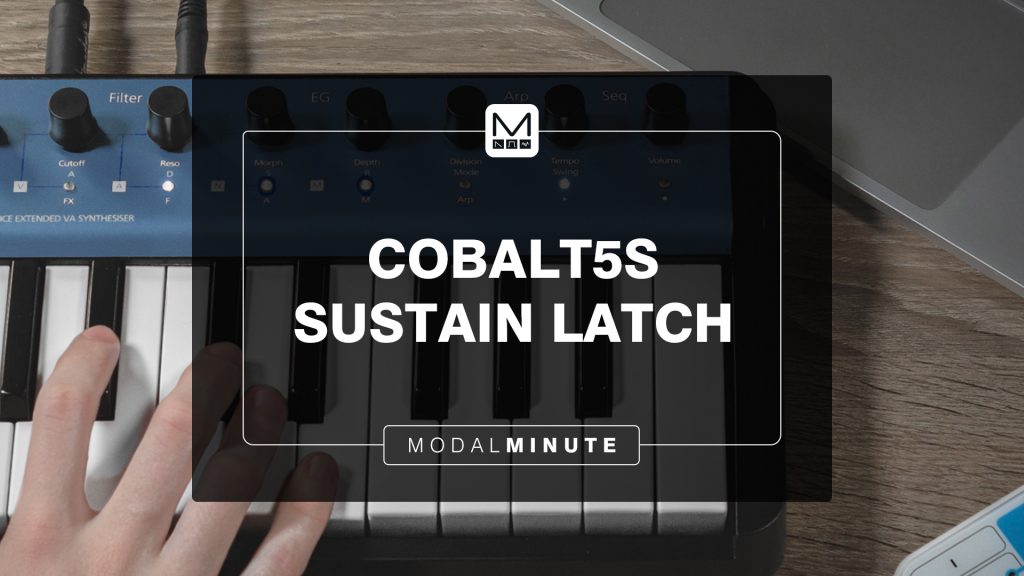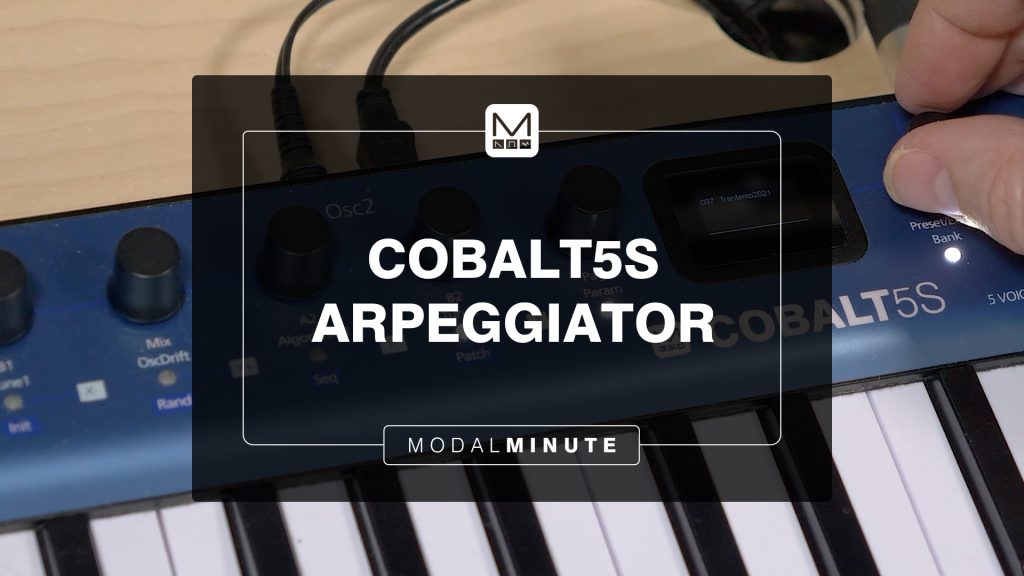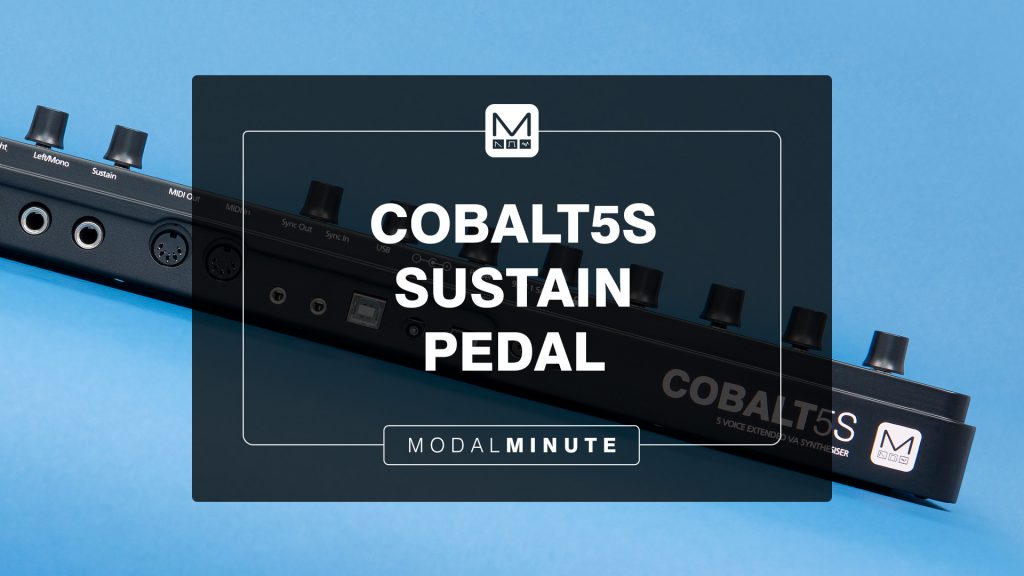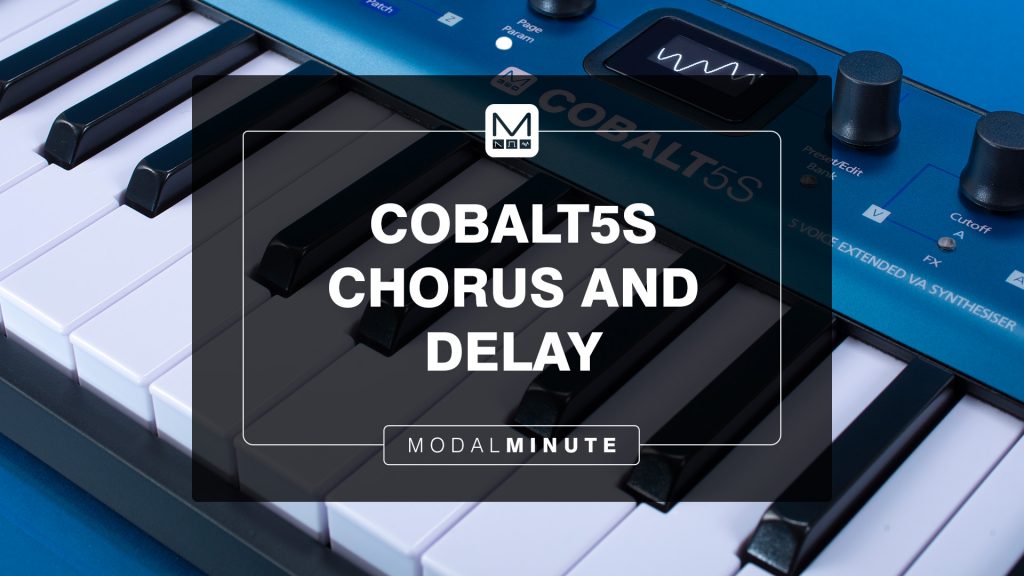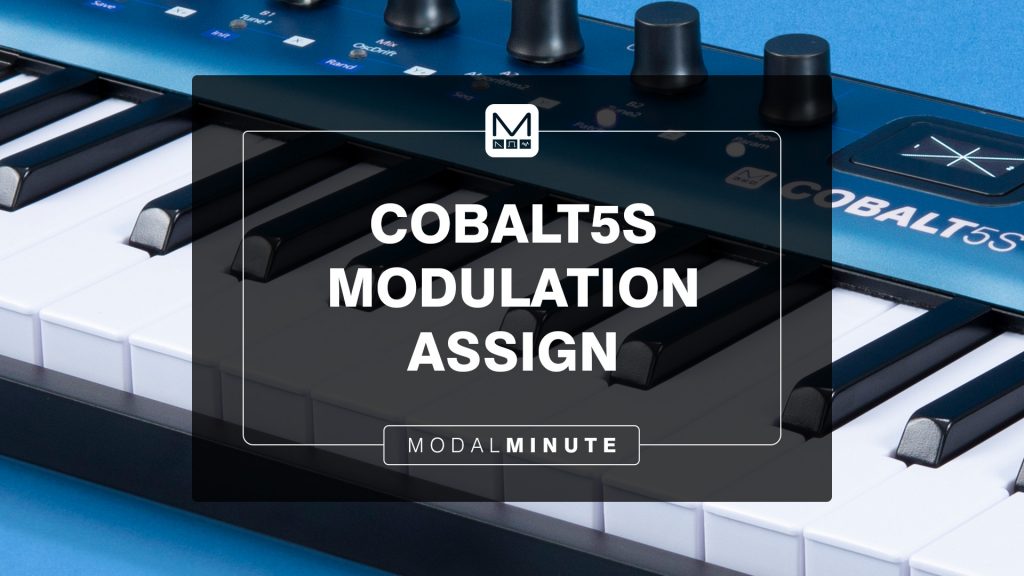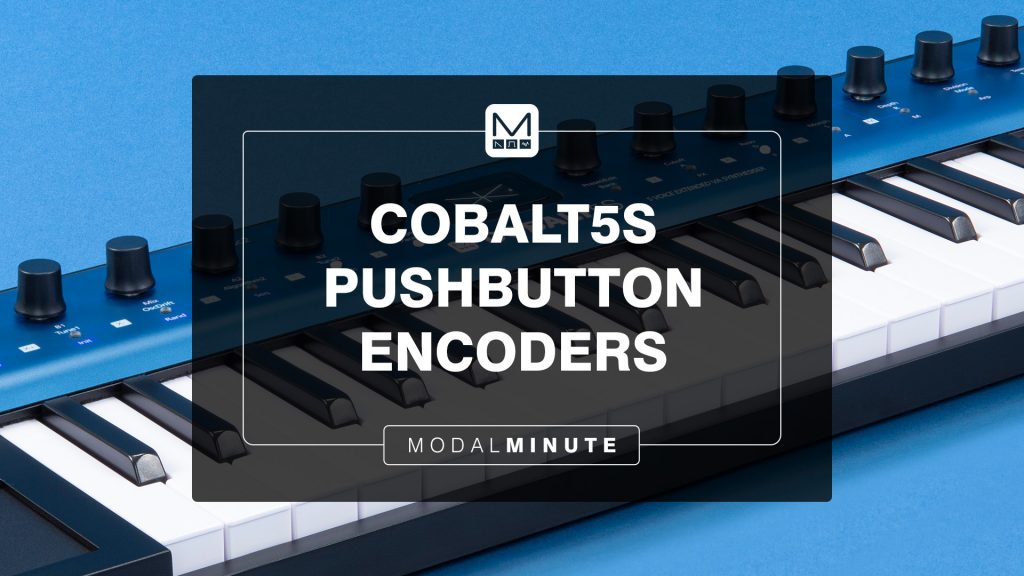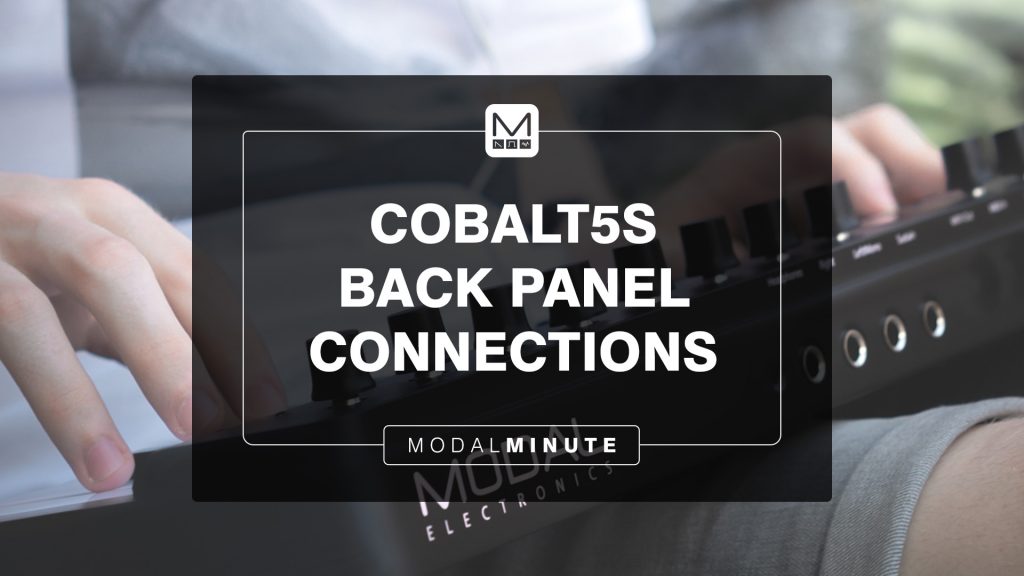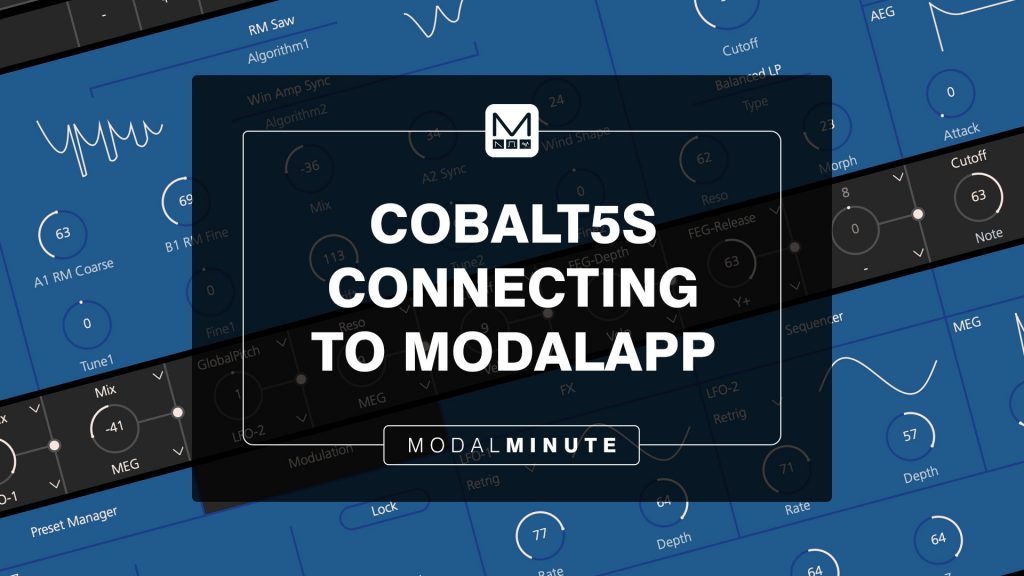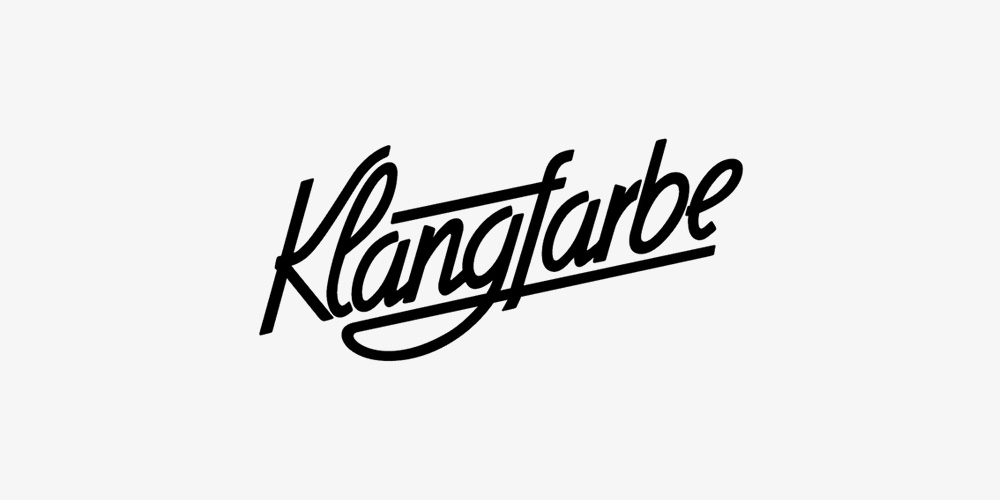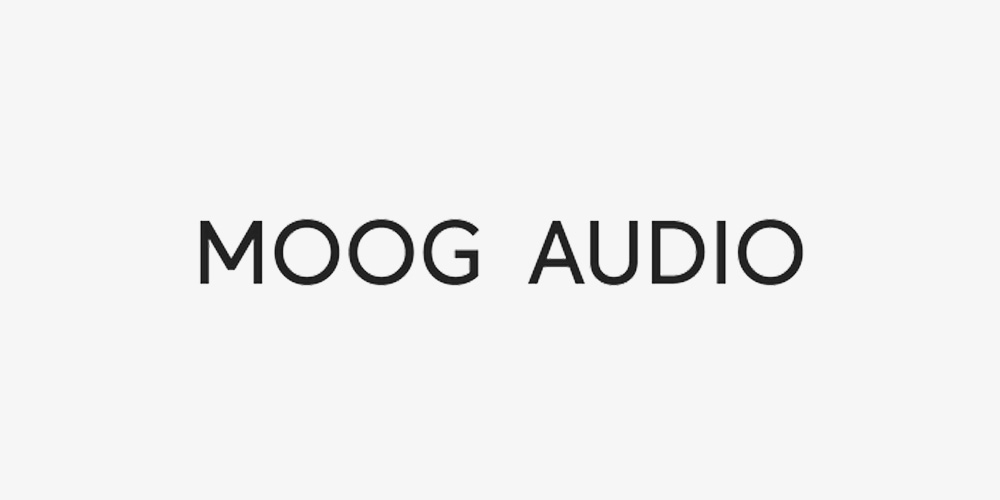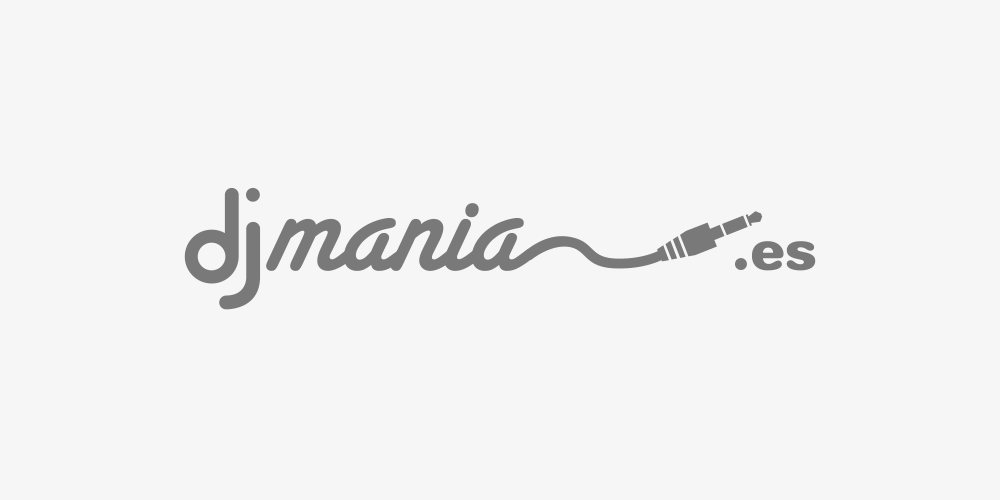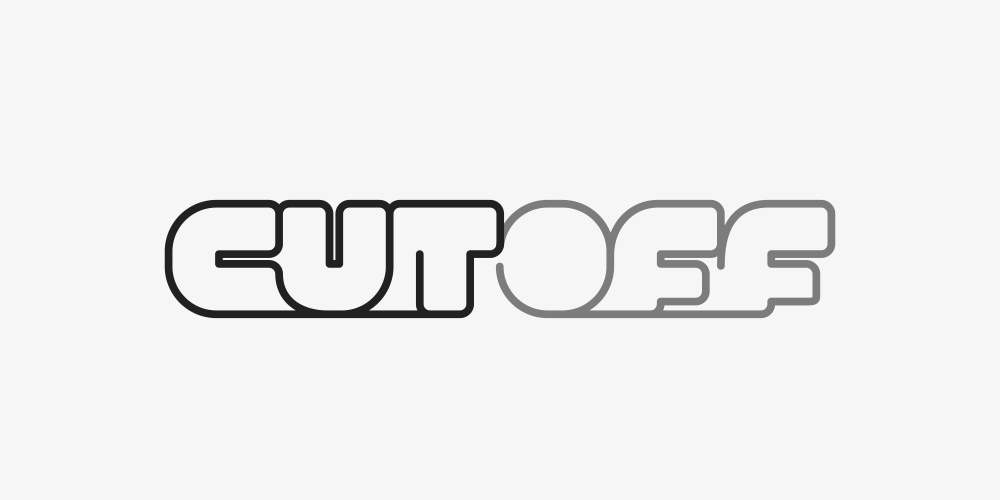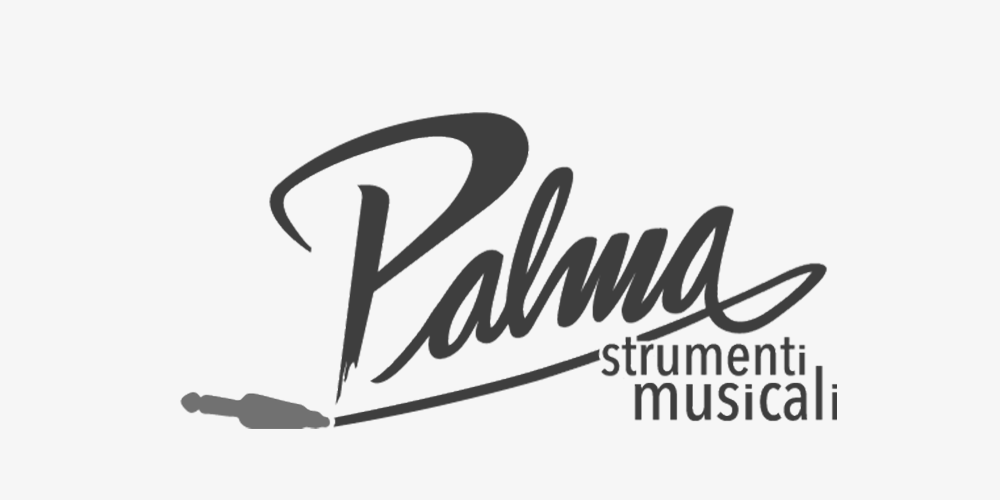Ce site utilise des cookies afin que nous puissions vous fournir la meilleure expérience utilisateur possible. Les informations sur les cookies sont stockées dans votre navigateur et remplissent des fonctions telles que vous reconnaître lorsque vous revenez sur notre site Web et aider notre équipe à comprendre les sections du site que vous trouvez les plus intéressantes et utiles.


COBALT5S
Synthétiseur virtuel-analogique étendu à 5 voix
Basé sur l’architecture du synthétiseur COBALT de nouvelle génération de Modal Electronics et logé dans un boîtier ultra-portable, le COBALT5S alimenté par USB est conçu pour être déplacé et prêt à stimuler votre créativité partout et à tout moment. Qu’il s’agisse d’une reproduction singulièrement authentique de sons analogiques classiques ou d’une texture contemporaine de pointe, le moteur de sons analogiques virtuels étendus de la COBALT5S répond à toutes les attentes.
Le COBALT5S s’inspire du son iconique de ses prédécesseurs analogiques, transcendant toutes les limitations pour créer une architecture de synthé de pointe, véritablement mobile – des lignes de basse sulfureuses aux lits expansifs et mutants, et partout ailleurs, le COBALT5S ne se contente pas de modéliser des sons analogiques ordinaires, il va au-delà de l’analogique, partout.
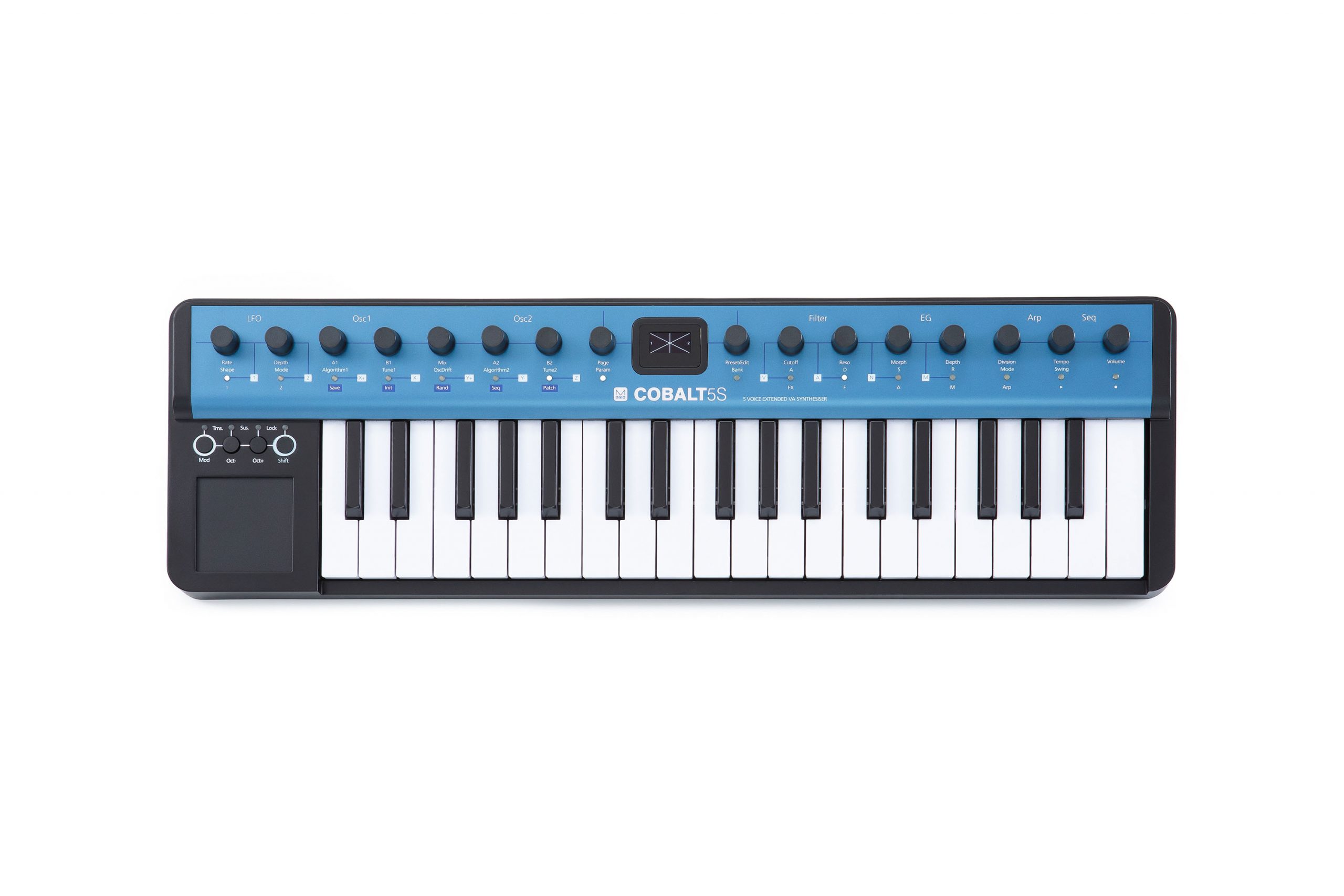
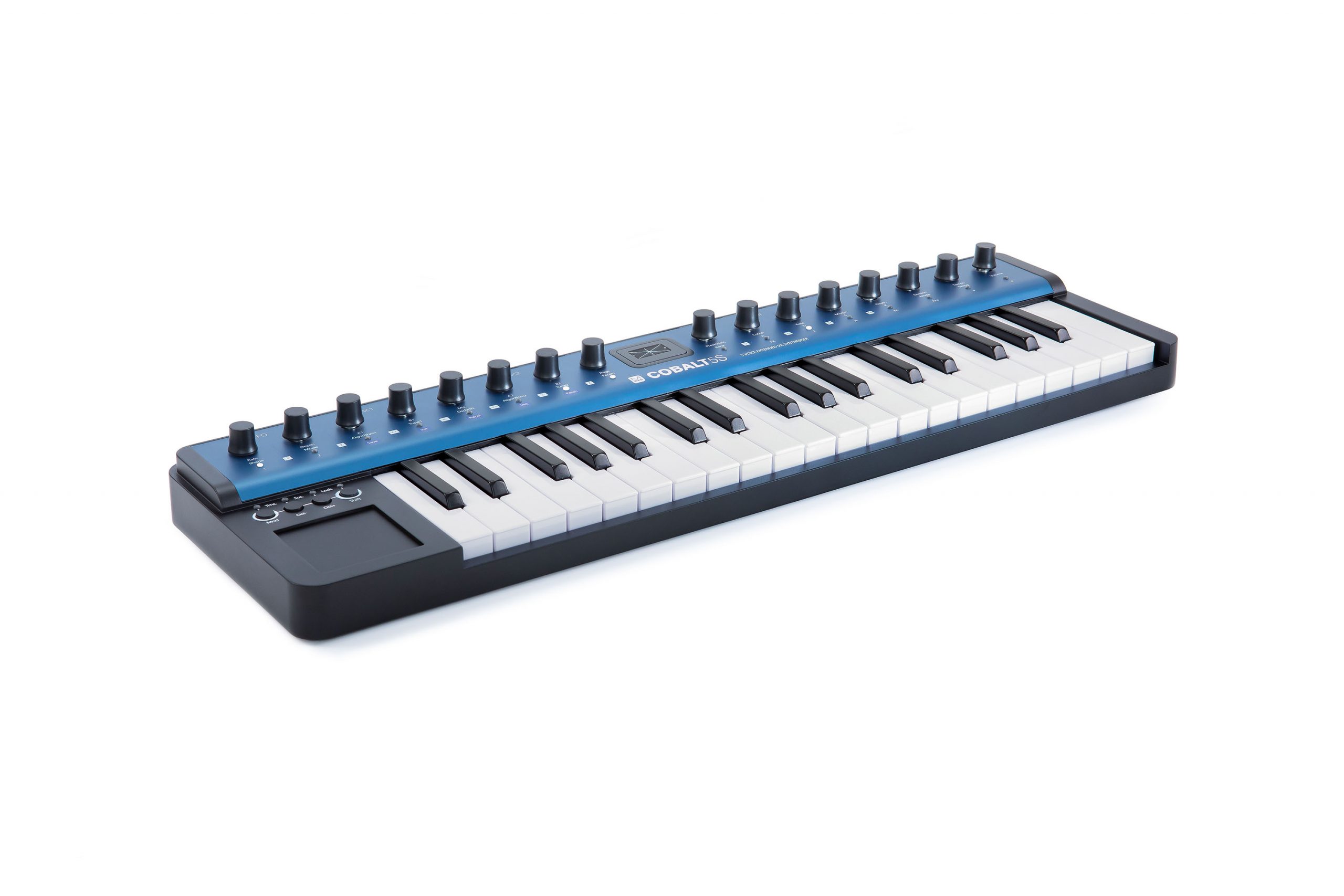
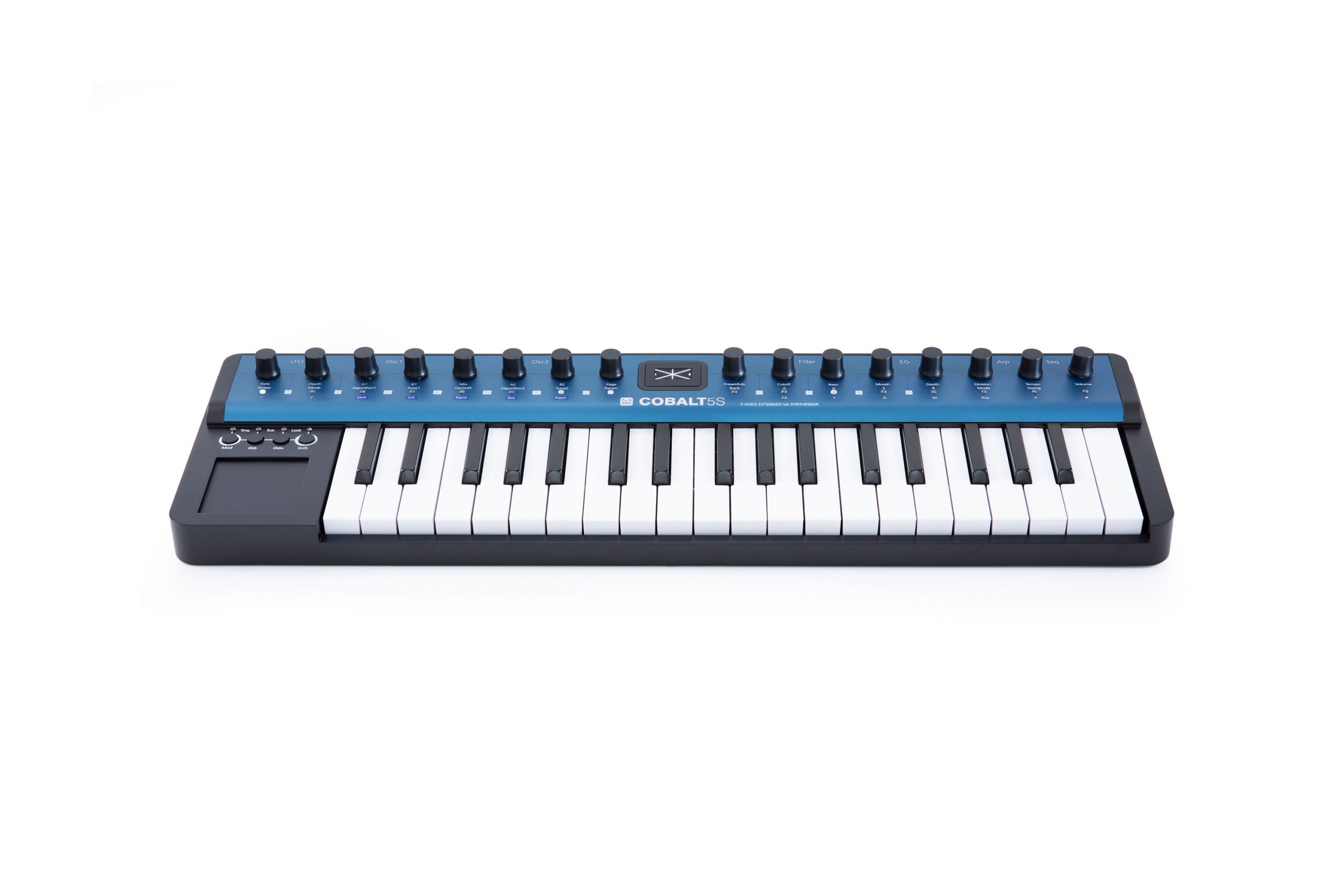
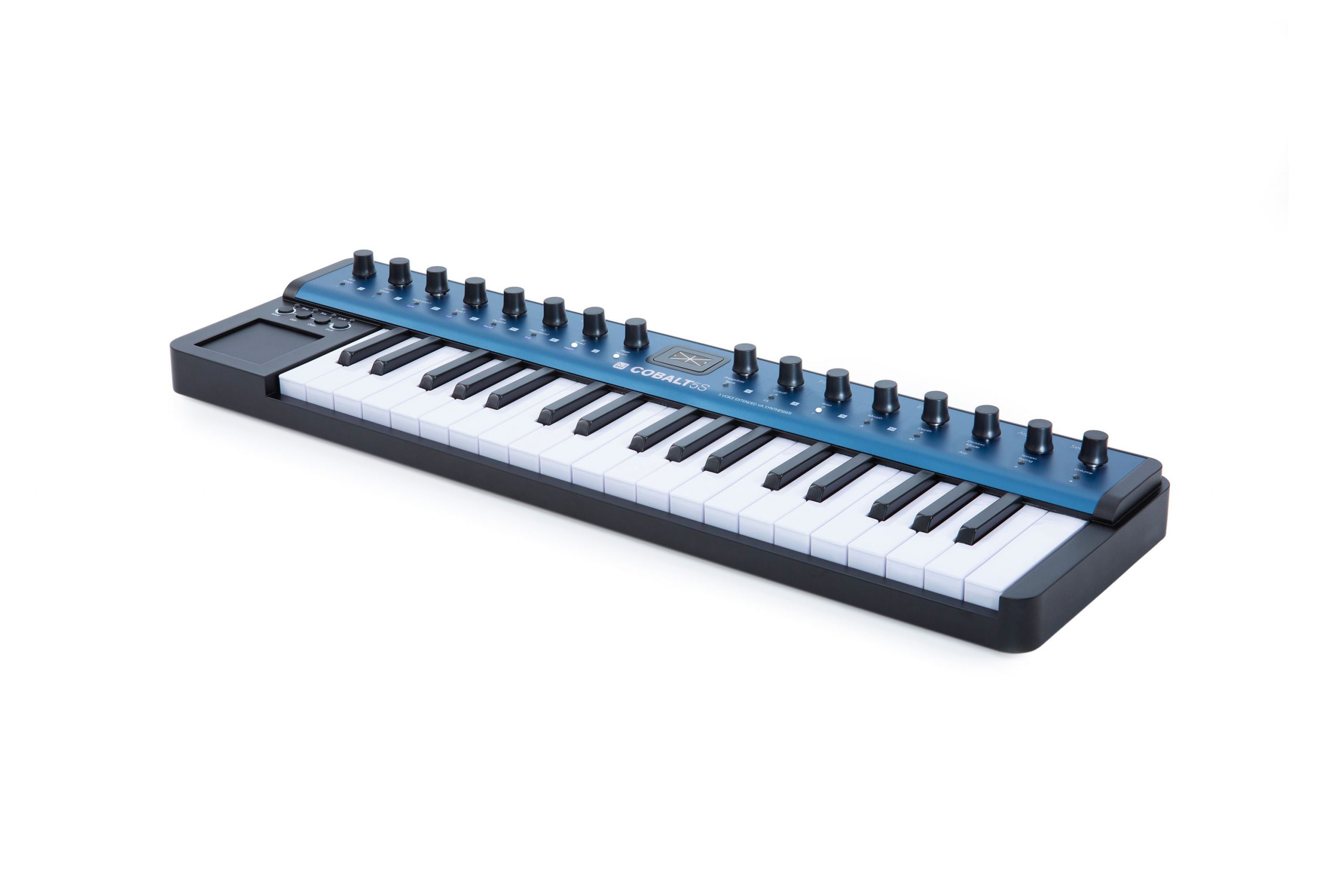
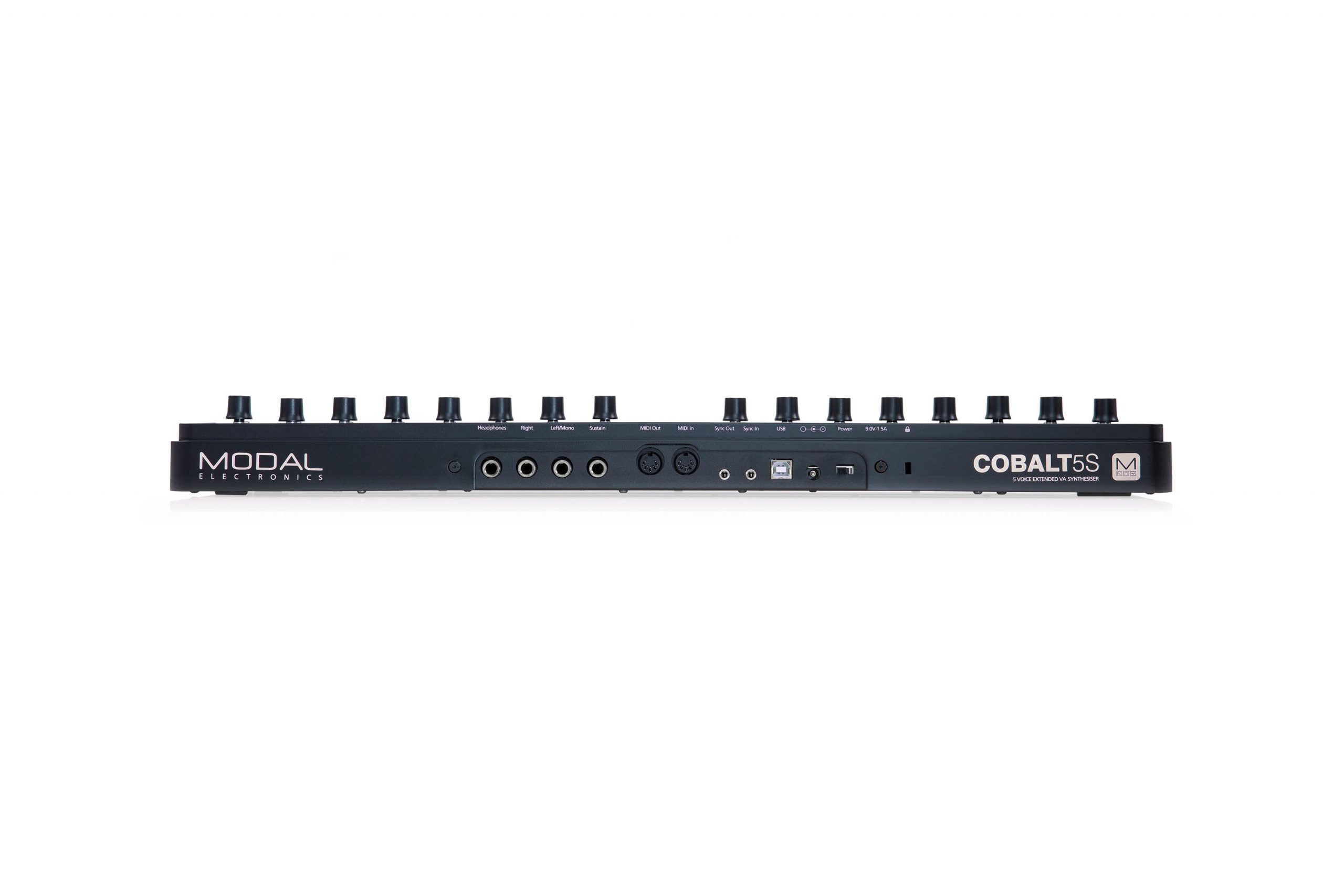
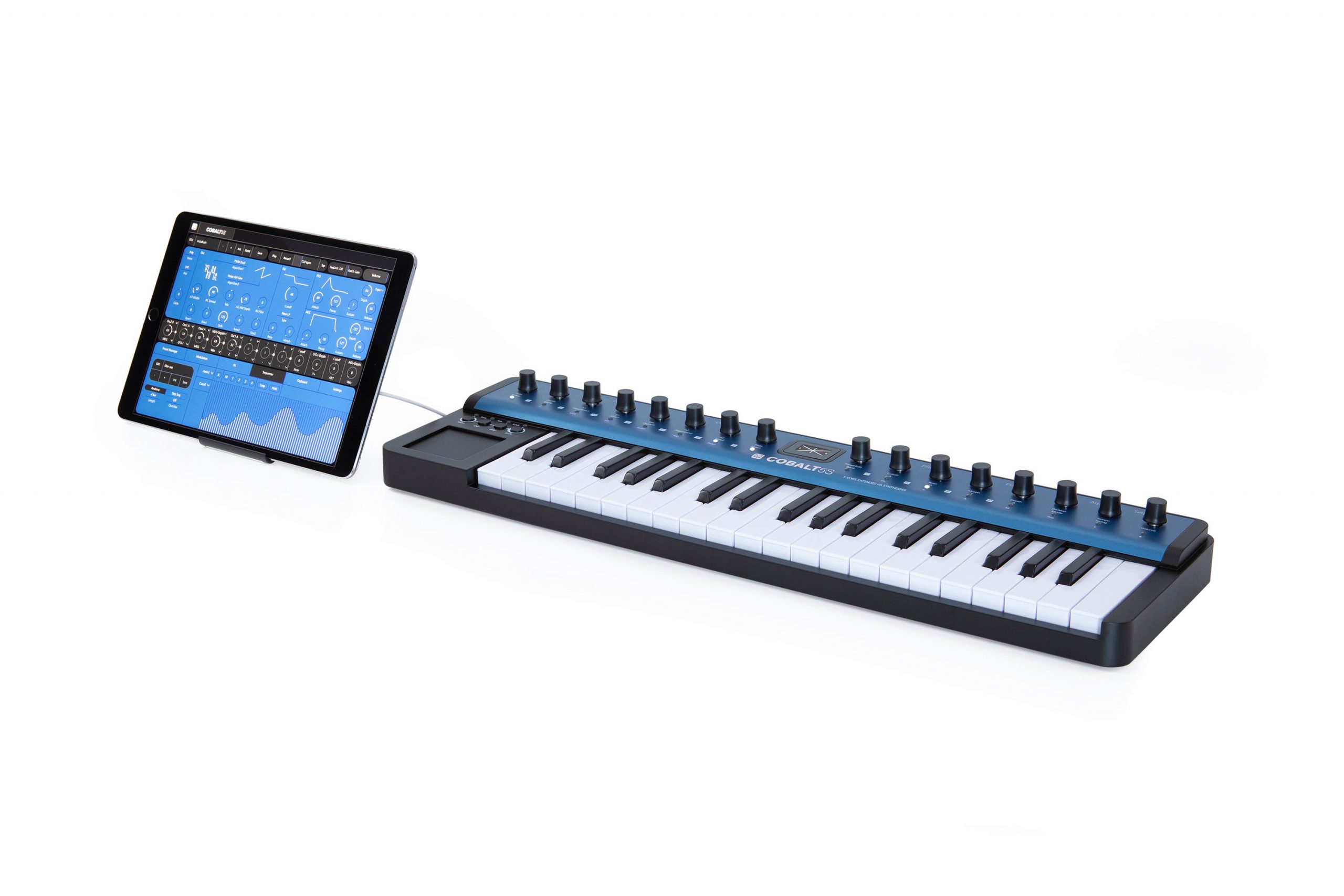

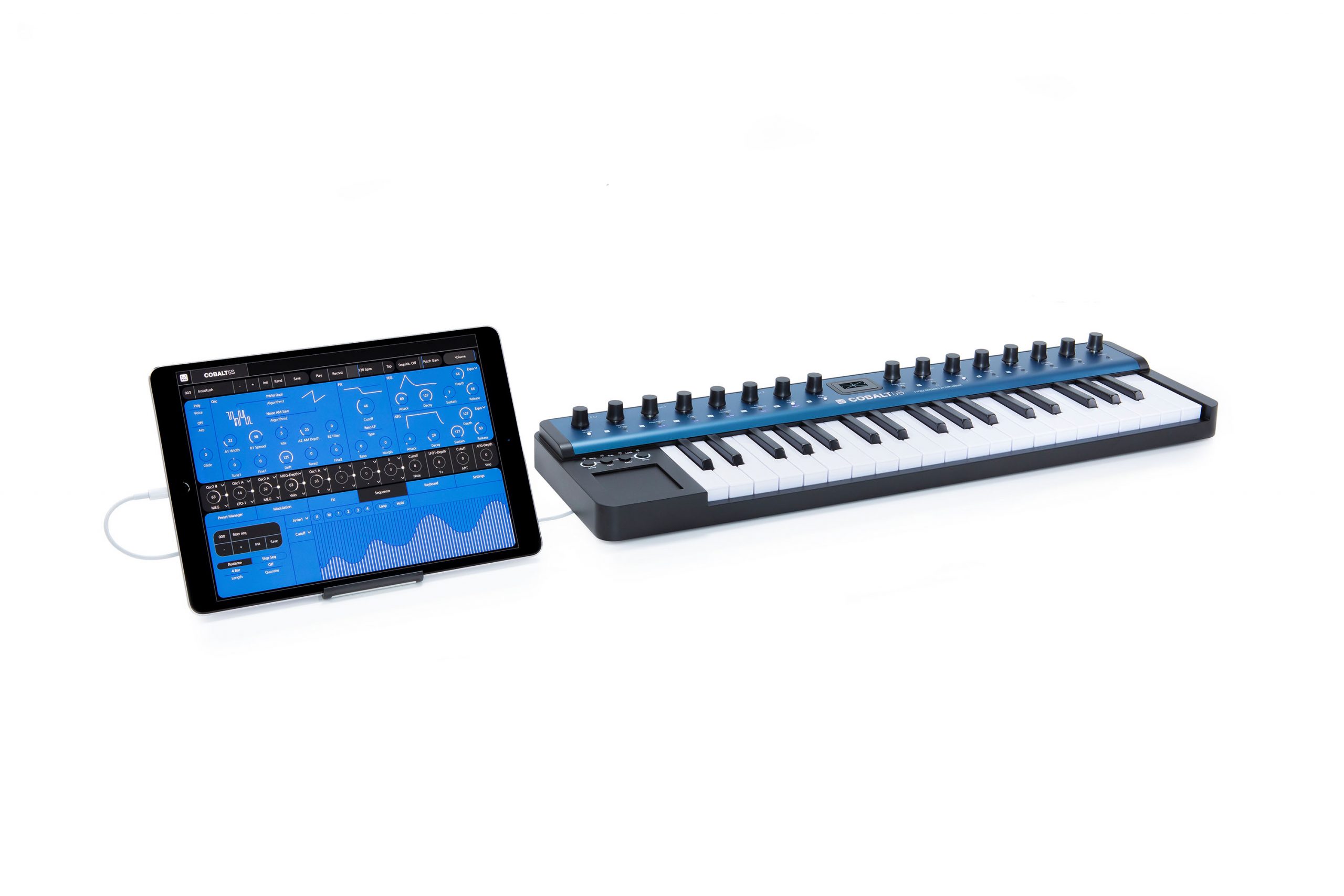
Réaliser n'importe quelle performance en utilisant un moteur de synthèse analogique virtuelle étendue de nouvelle génération
Créez tous les sons, des plus classiques aux plus pointus, grâce à 40 algorithmes complexes et sophistiqués et au filtre Ladder 4 pôles morphable de Modal.
Découvrez un nouveau niveau de performance avec la prise en charge MPE, un séquenceur temps réel/étapes intégré et deux moteurs FX.
Exprimez-vous grâce à un clavier compact de 37 notes avec aftertouch, un pavé tactile intuitif X/Y/Z et 16 encodeurs commutés.
Intégrez le COBALT5S dans votre installation existante ou alimentez-le via USB pour une utilisation nomade.
Accédez à toutes les fonctions du synthé via la MODALapp gratuite, disponible sur macOS, Windows, iOS, iPadOS, Android et AU/VST3.
Demos




Algorithms
- VA Sweep: Sweep through sine, triangle, saw, square, pulse (with pulse width) (A), ability to detune the oscillators (or snap to musical intervals) using spread (B)
- VA Crushed: Sweep through sine, triangle and saw shapes (A) with real-time control over bit crushing (B)
- Spread Saw: Spread mode with increased oscillator count, ability to blend between the fundamental and detuned oscillators (A) and more comprehensive spread (B) options (e.g oct up + detuned)
- Spread Square: Spread mode with increased oscillator count, ability to blend between the fundamental and detuned oscillators (A) and more comprehensive spread (B) options (e.g oct up + detuned)
- Spread Triangle: Spread mode with increased oscillator count, ability to blend between the fundamental and detuned oscillators (A) and more comprehensive spread (B)options (e.g oct up + detuned)
- PWM: Classic Pulse Width Modulation with width control (A) and ability to detune the oscillators using spread (B)
- PWM Dual: PWM mode where as the width control (A) changes, the pulse width increases in the first cycle of the wave and decreases in the second cycle. Oscillators can be detuned using the spread (B) control
- PWM Triangle / Square: Alternating triangle and square waves with control over the width of the triangle portion (A) and an asymmetry control (B) that allows every second cycle to have a different triangle width (inverse) to the first
- PWM Saw Eraser: Wave with both a saw and PWM portion, with control over the ratio between the two portions (A) and the width of the PWM portion (B) relative to parameter A
- PWM Triangle Pinch: Triangle wave with pulse width modulation (A) and an asymmetry control (B) which allows every second cycle of the wave to have a different width to the first (can be wider or narrower)
- Hard Sync Saw: Classic hard sync with un-quantised ratio (A) that can be blended with a sub oscillator (B) one octave below the fundamental
- Hard Sync Square: Classic hard sync with un-quantised ratio (A) that can be blended with a sub oscillator (B) one octave below the fundamental
- Hard Sync Triangle: Classic hard sync with un-quantised ratio (A) that can be blended with a sub oscillator (B) one octave below the fundamental
- Fractal Saw: Complex sync with un-quantised control over ratio (A) and and an asymmetry control (B) that allows every second cycle of the wave to have a different sync ratio to the first
- Fractal Square: Complex sync with un-quantised control over ratio (A) and and an asymmetry control (B) that allows every second cycle of the wave to have a different sync ratio to the first
- Fractal Triangle: Complex sync with un-quantised control over ratio (A) and and an asymmetry control (B) that allows every second cycle of the wave to have a different sync ratio to the first
- Reverse Saw: Periodically reverses the direction of the waveform and changes the playback rate (A), asymmetry control (B) changes the period length (I.e the switch point within a cycle)
- Reverse Square: Periodically reverses the direction of the waveform and changes the playback rate (A), asymmetry control (B) changes the period length (I.e the switch point within a cycle)
- Reverse Triangle: Periodically reverses the direction of the waveform and changes the playback rate (A), asymmetry control (B) changes the period length (I.e the switch point within a cycle)
- Window Amp Sync: Applies amplitude modulation to a sine wave using a hard synced waveform. Features an un-quantised sync ratio control (A) and the ability to morph between multiple window shapes (B)
- Metal Saw: Creates ring modulation/amplitude modulation like effects by syncing a waveform to two separate signals, one at the base rate and one at the sync rate. Features un-quantised control over sync rate (A) and ability to balance between the base wave and the modulated signal (B)
- Metal Square: Creates ring modulation/amplitude modulation like effects by syncing a waveform to two separate signals, one at the base rate and one at the sync rate. Features un-quantised control over sync rate (A) and ability to balance between the base wave and the modulated signal (B)
- Metal Triangle: Creates ring modulation/amplitude modulation like effects by syncing a waveform to two separate signals, one at the base rate and one at the sync rate. Features un-quantised control over sync rate (A) and ability to balance between the base wave and the modulated signal (B)
- Ring Mod Saw: Ring mod applied to two saw waves, with quantised ratio control (A) that snaps through a series of useful ratios, and a fine control (B), which cross-fades between these ratios allowing precise control across the whole range
- Ring Mod Square: Ring mod applied to two square waves, with quantised ratio control (A) that snaps through a series of useful ratios, and a fine control (B), which cross-fades between these ratios allowing precise control across the whole range
- Ring Mod Triangle: Ring mod applied to two triangle waves, with quantised ratio control (A) that snaps through a series of useful ratios, and a fine control (B), which cross-fades between these ratios allowing precise control across the whole range
- Ring Mod Triangle / Square: Ring mod applied to a triangle and a square wave, with quantised ratio control (A) that snaps through a series of useful ratios, and a fine control (B), which cross-fades between these ratios allowing precise control across the whole range
- Ring Mod Saw / Square: Ring mod applied to a saw and square wave, with quantised ratio control (A) that snaps through a series of useful ratios, and a fine control (B), which cross-fades between these ratios allowing precise control across the whole range
- Ring Mod Saw / Triangle: Ring mod applied to a saw and triangle wave, with quantised ratio control (A) that snaps through a series of useful ratios, and a fine control (B), which cross-fades between these ratios allowing precise control across the whole range
- Chaos Saw: Un-quantised ring modulation (A) combined with randomisation (B)
- Chaos Square: Un-quantised ring modulation (A) combined with randomisation (B)
- Chaos Triangle: Un-quantised ring modulation (A) combined with randomisation (B)
- Fold Triangle: Triangle wave-folding (A) with DC offset (B)
- Filtered Noise: Noise generator combined with a morphable filter with full control over Cutoff (A) and Morph (B)
- FM Saw:Square: Frequency Modulation using a Sawtooth as the carrier and a Square as the modulator with full control over FM Depth (A) and Modulator Frequency Ratio (B)
- FM Square:Square: Frequency Modulation using a Square as both the carrier and modulator with full control over FM Depth (A) and Modulator Frequency Ratio (B)
- FM Tri:Square: Frequency Modulation using a Triangle as the carrier and a Square as the modulator with full control over FM Depth (A) and Modulator Frequency Ratio (B)
- Noise AM Saw: Sawtooth Wave amplitude modulated by a filtered noise source with full control over AM Depth (A) and Noise filter cutoff (B)
- Noise AM Square: Square Wave amplitude modulated by a filtered noise source with full control over AM Depth (A) and Noise filter cutoff (B)
- Noise AM Tri: Triangle Wave amplitude modulated by a filtered noise source with full control over AM Depth (A) and Noise filter cutoff (B)
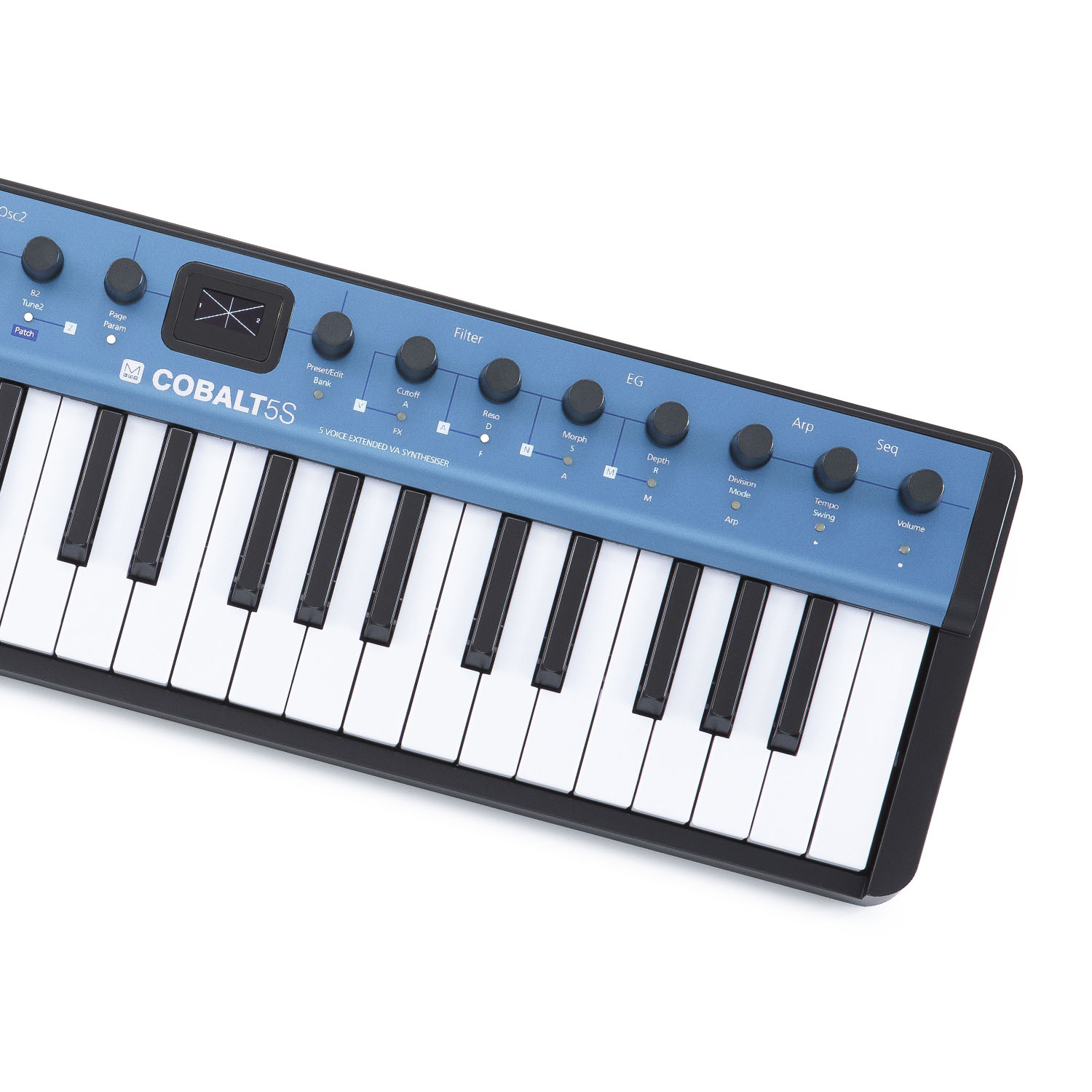
Créer sans limite
Avec cinq voix véritablement polyphoniques, deux groupes d’algorithmes indépendants et jusqu’à 8 oscillateurs par voix, les musiciens, les concepteurs sonores et les producteurs sont armés d’une palette sonore infernale, prête à toutes les applications imaginables. Ajoutez à cela 40 algorithmes complexes, dont Sync, Ring Modulation, Waveform Morphng, et bien d’autres encore, et vous comprendrez aisément pourquoi la COBALT5S offre aux créateurs une capacité de sculpture sonore sans limite.
Earcandy
Doté du même filtre Ladder Morphable 4 pôles auto-oscillant que le COBALT8, le COBALT5S garantit une texture sonore avec tout le mordant et la chaleur que votre performance exige. Quatre modes de filtrage distincts fusionnent avec les contrôles classiques de coupure et de résonance, ainsi qu’un paramètre de morphologie permettant de manipuler musicalement la réponse en fréquence du filtre pour une expérience véritablement immersive. Du sublime à l’expérimental, en passant par tous les extrêmes, la création du timbre parfait n’est limitée que par votre imagination.
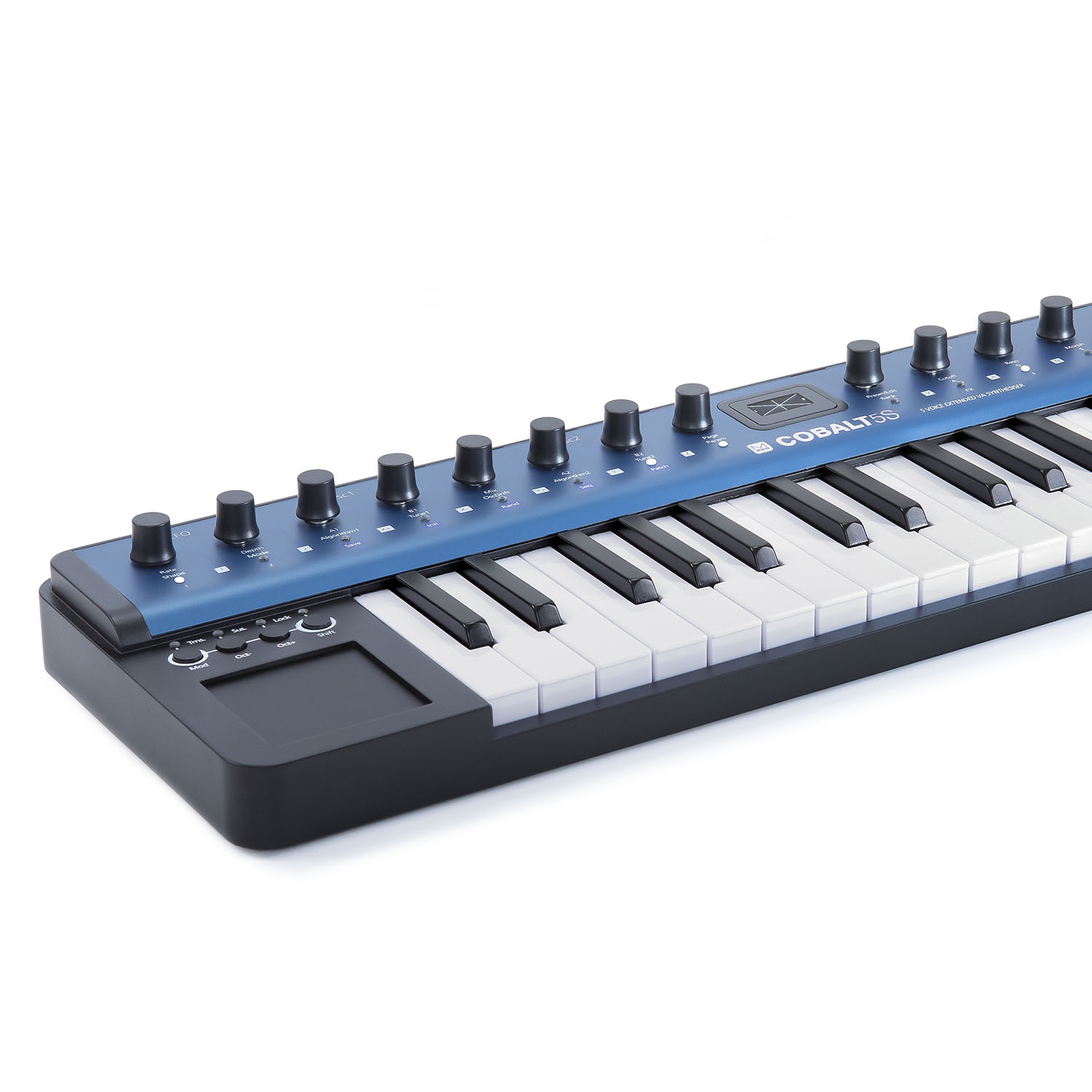
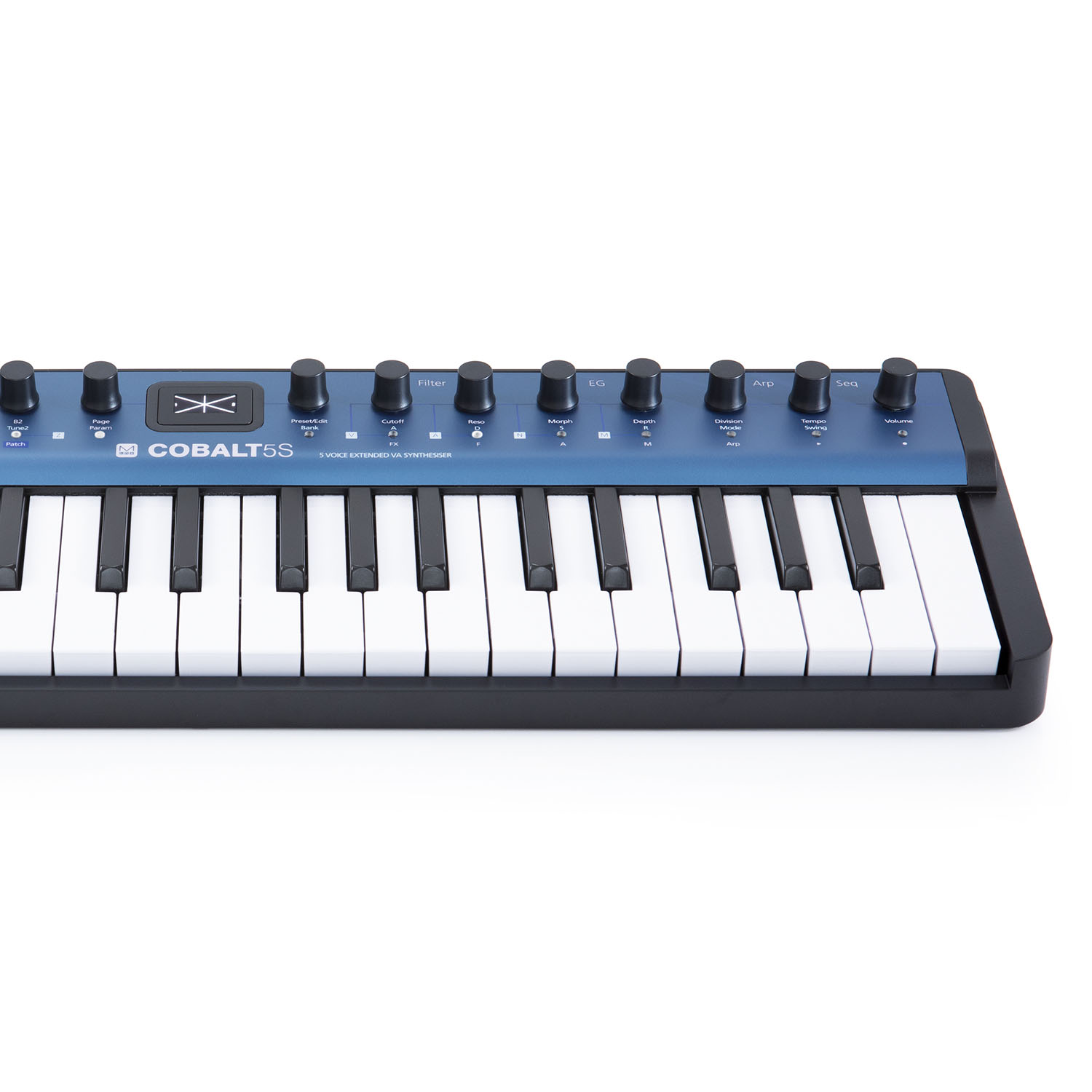
La mise en forme de votre son, simplifiée !
Tout ce dont vous avez besoin pour créer le son parfait dans les moindres détails est à portée de main avec le COBALT5S. Trois enveloppes avec des types sélectionnables prennent le contrôle du filtre, de l’ampli ou des destinations de modulation, vous offrant ainsi des options illimitées lorsqu’il s’agit de peaufiner votre son. Un LFO polyphonique et un LFO global offrent une puissance étendue pour contrôler une pléthore de sources de modulation, sélectionnées via une matrice de modulation sophistiquée à 8 emplacements. Qu’il s’agisse d’un paysage sonore évolutif d’un autre monde, de pads rythmiques ou d’un lead fulgurant, la réalisation de votre vision créative n’a jamais été aussi facile!
Votre performance, suralimentée !
Lancez-vous avec le séquenceur temps réel/pas à pas intégré de 512 notes, avec 4 voies d’animation. Ajoutez à cela un arpégiateur intégré programmable de 32 pas et vous commencez à entrevoir les possibilités de performance que COBALT5S offre au créateur moderne. Ajoutez à cela la prise en charge MPE pour une expression créative de nouvelle génération via un contrôleur MPE compatible, et vous obtenez un COBALT5S prêt pour tout scénario de performance, de production ou de conception sonore imaginable.
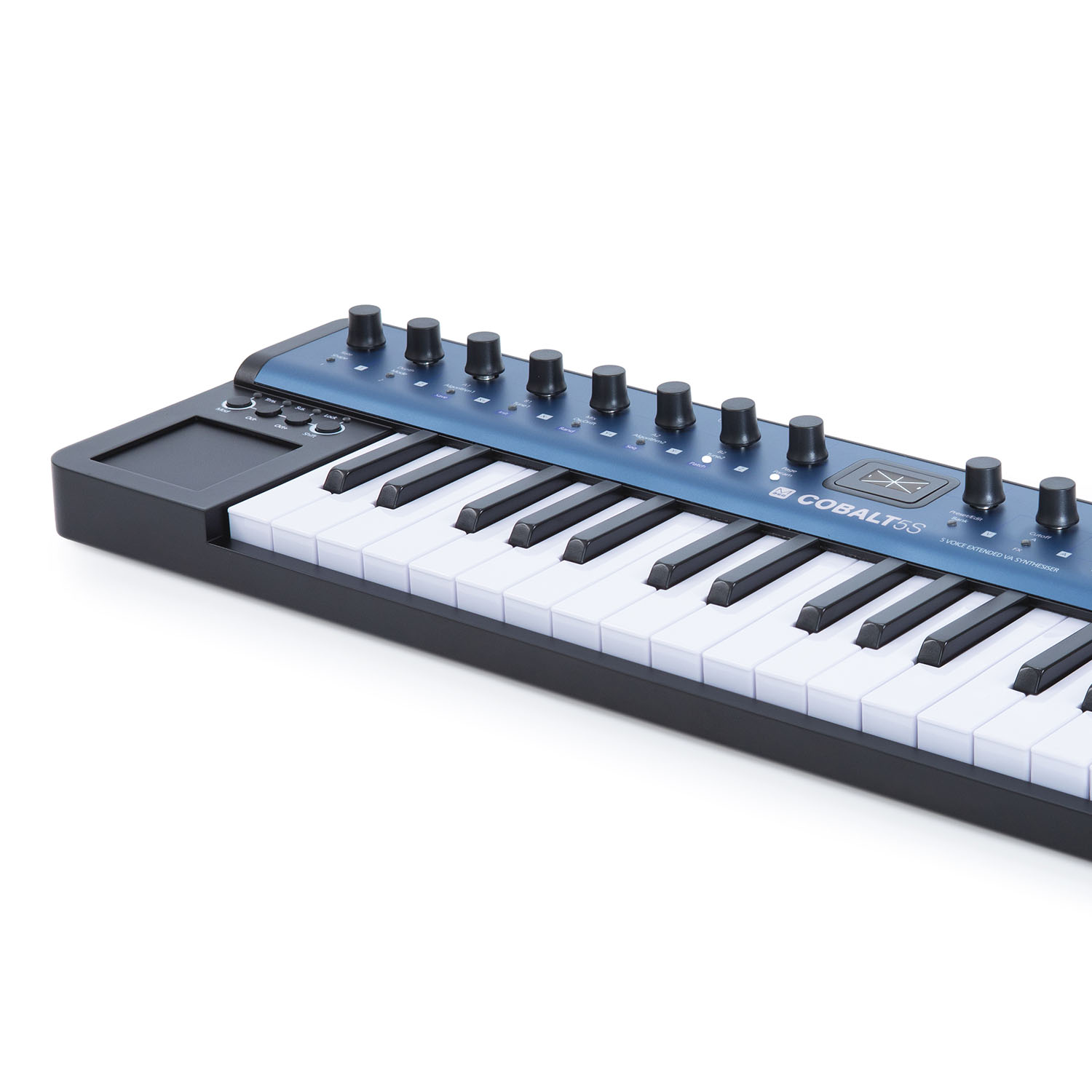
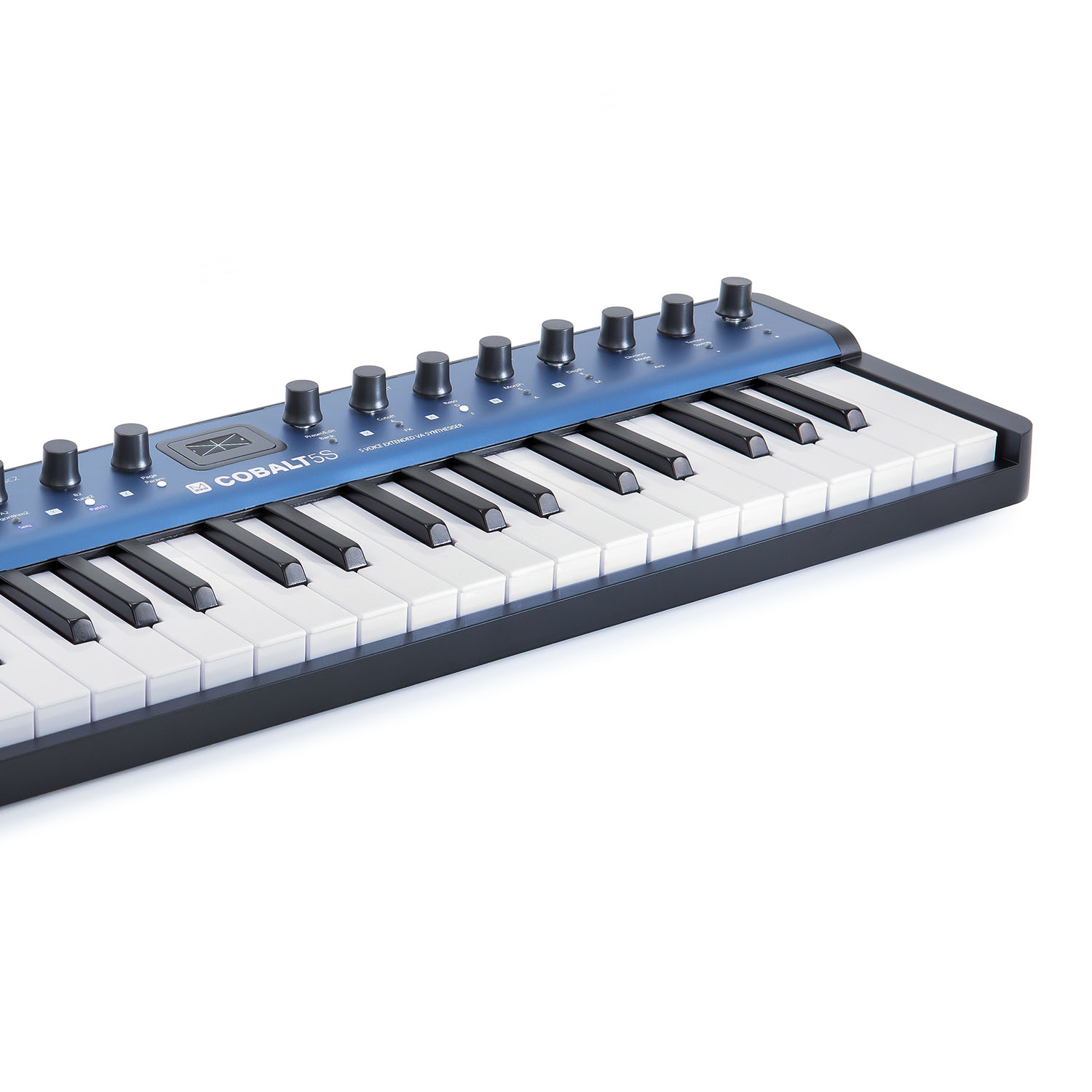
Fabriqué pour bouger
Quand nous disons qu’il s’agit du Beyond Analogue Anywhere, nous le pensons vraiment. Reprenant la qualité de fabrication légendaire synonyme de la gamme de synthétiseurs de Modal Electronics, et l’équipant d’un clavier compact de 37 notes avec aftertouch, le COBALT5S est prêt pour vos exploits créatifs, où que vous soyez. De plus, avec une spécification d’alimentation USB, l’alimentation du COBALT5S à partir de votre Mac/PC ou d’une brique d’alimentation portable ne pourrait pas être plus simple.
Contrôle, évolué
Prenez le contrôle total et créez votre propre son avec facilité grâce aux 16 encodeurs commutés. Pour une capacité d’expression totale, le pavé tactile X/Y/Z du COBALT5S offre un contrôle ultime sur 5 axes pour le pitch bend, la molette de modulation et/ou toute affectation de modulation sélectionnée par l’utilisateur. Deux moteurs d’effets stéréo indépendants, comprenant un délai et un chorus, injectent de la profondeur et du caractère à vos patchs, vous permettant de créer des textures synthétiques raffinées. Pour compléter cet assortiment de commandes tactiles et axées sur les performances, un écran OLED monochrome rayonnant relaie toutes les informations clés que vous exigez avec une résolution très nette.
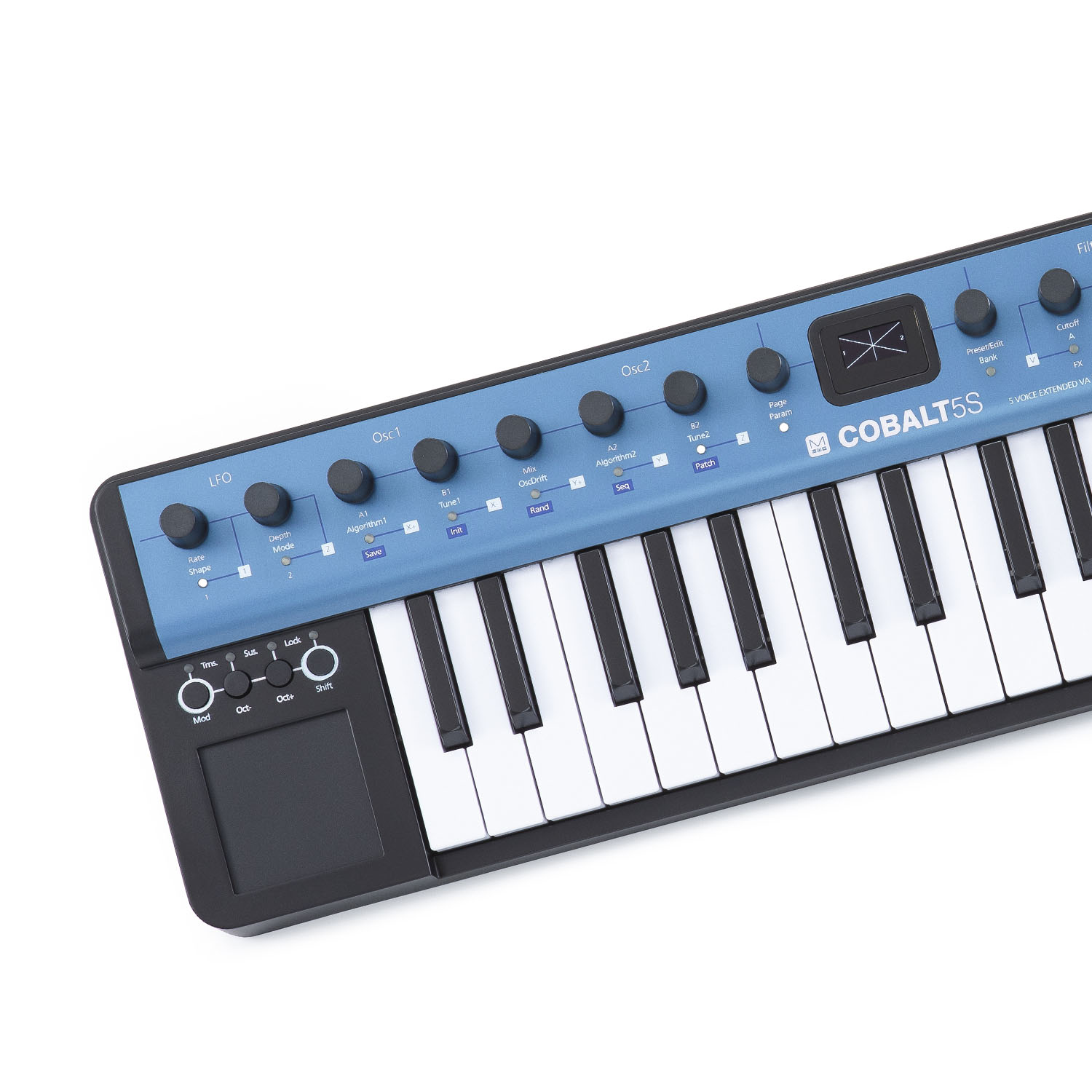
Flexibilité des raccordements
L’intégration du COBALT5S dans votre installation existante ne pourrait pas être plus simple. Connectez-le à des systèmes de sonorisation, des boîtiers de scène, des tables de mixage et bien plus encore grâce à deux prises de sortie de ligne ¼ pouce ; entraînez-vous en privé grâce à une sortie casque stéréo ¼ pouce ; ajoutez un véritable sustain de style piano à votre performance avec une entrée de pédale de sustain ¼ pouce ; connectez-le à tous vos périphériques MIDI grâce à des entrées et sorties MIDI pleine grandeur, ainsi qu’à la fonction MIDI over USB ; enfin, gardez tout au point avec l’entrée et la sortie de synchronisation d’horloge du COBALT5S. Quelles que soient les exigences de votre prochaine performance, la COBALT5S vous garantit de les assimiler avec facilité.

MODALapp gratuite pour des sessions de programmation sonore immersive
L’application gratuite MODALapp apporte le confort de l’édition sur écran sur votre ordinateur ou votre appareil mobile. Disponible sous forme d’application autonome pour les systèmes macOS, Windows, iOS, iPadOS ou Android et aux formats de plug-in VST3 et AU, c’est le compagnon idéal pour les passionnés de synthé qui cherchent à plonger en profondeur vers tous les paramètres d’édition sonore et de performance. La création de votre propre signature sonore, la sauvegarde de votre bibliothèque et la gestion de vos patchs et séquences ne pourraient pas être plus simples.

Spécifications
Polyphonie
Véritable polyphonie à 5 voix
MPE
Prend en charge les contrôleurs MIDI compatibles MPE, ce qui vous permet d’appliquer un contrôle et une expression polyphoniques aux notes individuelles.
Oscillateurs
40 oscillateurs analogiques virtuels haute résolution, jusqu’à 8 par voix.
Deux groupes d’oscillateurs indépendants et autonomes avec des formes d’ondes sinusoïdales, pulsées, triangulaires, en dents de scie, 40 algorithmes différents comprenant : des techniques complexes de synthèse analogique, une crossmodulation intégrée (SYNC, RM, et bien d’autres), PWM, un morphing fluide entre les ondes VA, un écrasement de bits, un bruit filtré.
Dérive étendue de l’oscillateur
Algorithms
- VA Sweep: Sweep through sine, triangle, saw, square, pulse (with pulse width) (A), ability to detune the oscillators (or snap to musical intervals) using spread (B)
- VA Crushed: Sweep through sine, triangle and saw shapes (A) with real-time control over bit crushing (B)
- Spread Saw: Spread mode with increased oscillator count, ability to blend between the fundamental and detuned oscillators (A) and more comprehensive spread (B) options (e.g oct up + detuned)
- Spread Square: Spread mode with increased oscillator count, ability to blend between the fundamental and detuned oscillators (A) and more comprehensive spread (B) options (e.g oct up + detuned)
- Spread Triangle: Spread mode with increased oscillator count, ability to blend between the fundamental and detuned oscillators (A) and more comprehensive spread (B)options (e.g oct up + detuned)
- PWM: Classic Pulse Width Modulation with width control (A) and ability to detune the oscillators using spread (B)
- PWM Dual: PWM mode where as the width control (A) changes, the pulse width increases in the first cycle of the wave and decreases in the second cycle. Oscillators can be detuned using the spread (B) control
- PWM Triangle / Square: Alternating triangle and square waves with control over the width of the triangle portion (A) and an asymmetry control (B) that allows every second cycle to have a different triangle width (inverse) to the first
- PWM Saw Eraser: Wave with both a saw and PWM portion, with control over the ratio between the two portions (A) and the width of the PWM portion (B) relative to parameter A
- PWM Triangle Pinch: Triangle wave with pulse width modulation (A) and an asymmetry control (B) which allows every second cycle of the wave to have a different width to the first (can be wider or narrower)
- Hard Sync Saw: Classic hard sync with un-quantised ratio (A) that can be blended with a sub oscillator (B) one octave below the fundamental
- Hard Sync Square: Classic hard sync with un-quantised ratio (A) that can be blended with a sub oscillator (B) one octave below the fundamental
- Hard Sync Triangle: Classic hard sync with un-quantised ratio (A) that can be blended with a sub oscillator (B) one octave below the fundamental
- Fractal Saw: Complex sync with un-quantised control over ratio (A) and and an asymmetry control (B) that allows every second cycle of the wave to have a different sync ratio to the first
- Fractal Square: Complex sync with un-quantised control over ratio (A) and and an asymmetry control (B) that allows every second cycle of the wave to have a different sync ratio to the first
- Fractal Triangle: Complex sync with un-quantised control over ratio (A) and and an asymmetry control (B) that allows every second cycle of the wave to have a different sync ratio to the first
- Reverse Saw: Periodically reverses the direction of the waveform and changes the playback rate (A), asymmetry control (B) changes the period length (I.e the switch point within a cycle)
- Reverse Square: Periodically reverses the direction of the waveform and changes the playback rate (A), asymmetry control (B) changes the period length (I.e the switch point within a cycle)
- Reverse Triangle: Periodically reverses the direction of the waveform and changes the playback rate (A), asymmetry control (B) changes the period length (I.e the switch point within a cycle)
- Window Amp Sync: Applies amplitude modulation to a sine wave using a hard synced waveform. Features an un-quantised sync ratio control (A) and the ability to morph between multiple window shapes (B)
- Metal Saw: Creates ring modulation/amplitude modulation like effects by syncing a waveform to two separate signals, one at the base rate and one at the sync rate. Features un-quantised control over sync rate (A) and ability to balance between the base wave and the modulated signal (B)
- Metal Square: Creates ring modulation/amplitude modulation like effects by syncing a waveform to two separate signals, one at the base rate and one at the sync rate. Features un-quantised control over sync rate (A) and ability to balance between the base wave and the modulated signal (B)
- Metal Triangle: Creates ring modulation/amplitude modulation like effects by syncing a waveform to two separate signals, one at the base rate and one at the sync rate. Features un-quantised control over sync rate (A) and ability to balance between the base wave and the modulated signal (B)
- Ring Mod Saw: Ring mod applied to two saw waves, with quantised ratio control (A) that snaps through a series of useful ratios, and a fine control (B), which cross-fades between these ratios allowing precise control across the whole range
- Ring Mod Square: Ring mod applied to two square waves, with quantised ratio control (A) that snaps through a series of useful ratios, and a fine control (B), which cross-fades between these ratios allowing precise control across the whole range
- Ring Mod Triangle: Ring mod applied to two triangle waves, with quantised ratio control (A) that snaps through a series of useful ratios, and a fine control (B), which cross-fades between these ratios allowing precise control across the whole range
- Ring Mod Triangle / Square: Ring mod applied to a triangle and a square wave, with quantised ratio control (A) that snaps through a series of useful ratios, and a fine control (B), which cross-fades between these ratios allowing precise control across the whole range
- Ring Mod Saw / Square: Ring mod applied to a saw and square wave, with quantised ratio control (A) that snaps through a series of useful ratios, and a fine control (B), which cross-fades between these ratios allowing precise control across the whole range
- Ring Mod Saw / Triangle: Ring mod applied to a saw and triangle wave, with quantised ratio control (A) that snaps through a series of useful ratios, and a fine control (B), which cross-fades between these ratios allowing precise control across the whole range
- Chaos Saw: Un-quantised ring modulation (A) combined with randomisation (B)
- Chaos Square: Un-quantised ring modulation (A) combined with randomisation (B)
- Chaos Triangle: Un-quantised ring modulation (A) combined with randomisation (B)
- Fold Triangle: Triangle wave-folding (A) with DC offset (B)
- Filtered Noise: Noise generator combined with a morphable filter with full control over Cutoff (A) and Morph (B)
- FM Saw:Square: Frequency Modulation using a Sawtooth as the carrier and a Square as the modulator with full control over FM Depth (A) and Modulator Frequency Ratio (B)
- FM Square:Square: Frequency Modulation using a Square as both the carrier and modulator with full control over FM Depth (A) and Modulator Frequency Ratio (B)
- FM Tri:Square: Frequency Modulation using a Triangle as the carrier and a Square as the modulator with full control over FM Depth (A) and Modulator Frequency Ratio (B)
- Noise AM Saw: Sawtooth Wave amplitude modulated by a filtered noise source with full control over AM Depth (A) and Noise filter cutoff (B)
- Noise AM Square: Square Wave amplitude modulated by a filtered noise source with full control over AM Depth (A) and Noise filter cutoff (B)
- Noise AM Tri: Triangle Wave amplitude modulated by a filtered noise source with full control over AM Depth (A) and Noise filter cutoff (B)
Filtre
Filtre Ladder Morphable à 4 pôles avec résonance et quatre configurations commutables
Modes de filtre résonnant et équilibré
Modulation
Trois générateurs d’enveloppe dédiés pour AMP, MOD et FILTER, accessibles indépendamment ou simultanément, y compris des versions négatives (inversées) pour les ENV MOD et FILTER.
Deux LFO avec synchronisation du tempo (un poly, un global) avec sept formes différentes.
Huit emplacements de modulation assignables et quatre routages de modulation fixes supplémentaires pour les affectations communes avec 11 sources de modulation et 41 destinations de modulation.
Séquenceur et arpégiateur
Séquenceur polyphonique en temps réel avec 512 notes et quatre animations de paramètres enregistrables/éditables (les effets de délai, les LFO, le séquenceur et l’arpégiateur peuvent être synchronisés en interne ou en externe).
Séquenceur polyphonique à pas de 64 pas, 5 notes par pas, 4 voies d’animation de style Parameter-Lock, mode Step Input, plusieurs modes de lecture, y compris des modes gate et une fonction de repos.
Arpégiateur programmable sophistiqué intégré de 32 pas avec fonction de repos et jusqu’à 2048 pas avant répétition
FX
Deux moteurs d’effets stéréo indépendants et configurables par l’utilisateur, incroyablement puissants, pour le chorus et le délai stéréo.
Mémoire de l'utilisateur
300 mémoires de patch, toutes entièrement modifiables ; livré avec 200 programmes d’usine
100 présélections de séquenceur qui peuvent être liées à n’importe quel patch pour charger rapidement des arrangements
4 emplacements de rappel rapide accessibles depuis le panneau pour charger rapidement vos patchs préférés
Contrôles et performance
Clavier compact de 37 touches de qualité supérieure avec vélocité et aftertouch de canal
16 encodeurs commutés permettant la transmission de messages CC en temps réel vers d’autres appareils MIDI ou DAWs
Pavé tactile à cinq axes X/Y/Z sensible à la pression pour les affectations de pitch bend, de mod wheel et/ou de modulation.
Modes de clavier multiples, Mono, Poly, Stack 2, Unison 2, Unison 4
Glide/Portamento avec modes legato et staccato.
Inputs and Outputs
Sorties ligne 6,35 mm / 1/4″ TS
Sortie casque 6,35 mm / 1/4″ TRS
Entrée et sortie MIDI DIN
Entrée et sortie de synchronisation d’horloge analogique 3,5 mm / 1/8″ TS
Connexion MIDI sur USB conforme à la norme
Entrée pour pédale de sustain 6,35 mm / 1/4″ TS
Boîtier et afficheur
Boîtier durable en polycarbonate
Ecran OLED monochrome pour un retour visuel instantané à tout moment de la lecture/édition
Alimentation
Alimentation : DC-9.0V – 1.5A centre-positif ou alimentation par bus USB
Editor Software
L’éditeur gratuit MODALapp est disponible pour macOS, Windows, iOS et Android.
MODALapp peut également être exécuté dans votre station de travail audio numérique (DAW), avec des versions VST3 et AU disponibles.
Général
Dimensions (L x l x H) : 56,5 x 16,2, x 5,7 cm / 22,24″ x 6,38″ x 2,24″.
Poids : 2,4 kg / 5,3 lbs
Sons
Conseils et astuces
Firmware
Firmware v1.1
Veuillez mettre à jour votre COBALT5S via l’application autonome MODALapp.
Software Editor
L’application gratuite MODALapp apporte le confort de l’édition sur écran sur votre ordinateur ou votre appareil mobile. Disponible en tant qu’application autonome pour les systèmes macOS, Windows, iOS, iPadOS ou Android et aux formats de plug-in VST3 et AU, c’est le compagnon idéal pour les passionnés de synthé qui cherchent à plonger en profondeur dans tous les paramètres de formation du son et de performance pour créer leurs propres sons caractéristiques.













